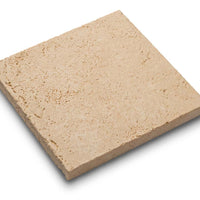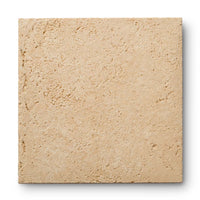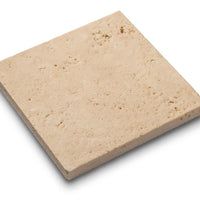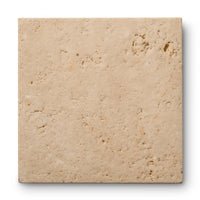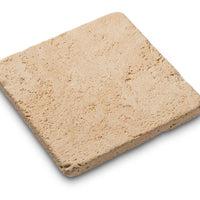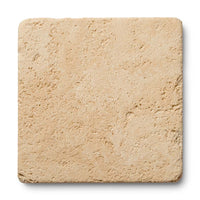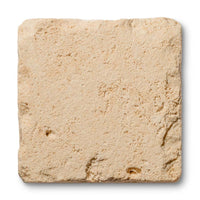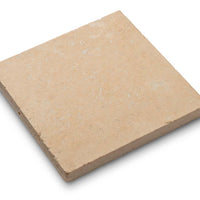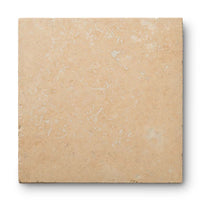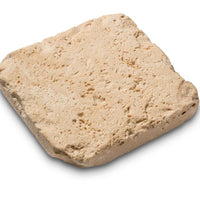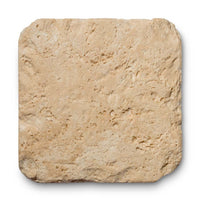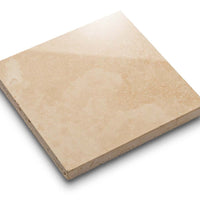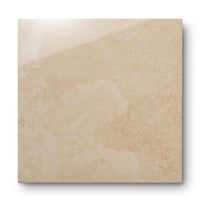Limestone Vs. Travertine

Natural stone is a gorgeous addition to any home. Not only is it durable and sustainable, but the natural elegance imbued in this type of stone offers a unique, timeless look.
Two favorite varieties of natural stone are limestone and travertine. Which you should choose for your home project depends on what you plan to use the stone for as well as the surrounding elements.
For example, limestone is stronger and more durable making it an ideal choice for stone flooring and outdoor projects. Travertine is more brittle so it’s better used as a wall stone tile and stone floor in areas with less traffic.
Both limestone and travertine will add a touch of luxury to your home’s decor. We’ve put together this short guide to introduce you to the properties of each stone. We’ll also discuss the benefits and drawbacks of limestone vs travertine and the best applications for each.
Limestone is a sedimentary rock made from the organic debris that gathers at the bottom of warm, shallow water, including the shells and skeletons of small marine animals. Limestone also contains traces of other minerals such as clay or quartz.
Over time, water currents or chemical processes cause the sediment to cement into a mass. The result of both biological and chemical cementation is a light-colored stone that is typically beige, tan, or cream.
The limestone used for tiles is very dense which makes it strong and long-lasting. To keep your limestone tile in top condition, you should use a sealant made specifically for this type of stone.
There are many benefits to using limestone in your home. People love this beautiful stone because of its qualities, such as:
Durable
Easy to maintain
Less porous than travertine
Timeless look
Uniform appearance
Many of these attributes make limestone an excellent choice for high-traffic areas as it’s less likely to crack or show wear over time.
Limestone does have a few drawbacks. These include:
Higher price
Lower heat resistance
Requires frequent cleaning
As you can see, limestone requires more frequent cleaning and isn’t as heat resistant as some other natural stone varieties. This means it’s not an ideal option for a wood-burning fireplace. However, people love to use limestone for:
Indoor flooring – Its strength makes limestone incredibly durable. Although you’ll have to clean it frequently to maintain the lovely color, you can expect your limestone floor to last for many years.
Bathrooms – Limestone is less porous than travertine so it can be used for bathroom tiles. If you’re using limestone near water, you should still seal it to protect it for long-term use.
Outdoor uses – Patios, garden walls, walkways, and other backyard structures can be made out of limestone for an alluring, natural appearance.
Gas or electric fireplaces – These don’t get as hot as wood-burning fireplaces. Limestone is perfectly fine to use for gas and electric fireplaces as well as on the surrounding walls as a decorative element. For more on fireplace designs, visit our blog for insight on the best stone for fireplace designs as well as arts and crafts fireplaces.
Travertine is actually a type of limestone. It differs in the manner in which it’s formed. The water that flows over the sediment to form travertine is hotter and more alkaline. The result is a rock that has veins and crevices throughout. It’s absolutely stunning in appearance and can be used for many design applications.
One of the more popular ways to cut travertine stone is a cross-cut, or vein-cut. This makes the veining in the stone visible which gives your home an eye-catching, glamorous look wherever you incorporate this delightful material. For further options, learn more on how CNC stone cutting could be right for you.
While it’s somewhat softer than limestone, limiting its usage and durability, there are still many benefits to travertine. These include:
No two stones are alike
Veining makes interesting patterns throughout
Can be treated to increase strength
Darker in color for easier cleaning
Even though its natural form is more brittle than limestone, there are sealants and fillers that can help protect the travertine and extend its lifetime.
That being said, travertine still requires more work to maintain than limestone. A few things you should be aware of if you have travertine in your home are:
Frequent sealing is a must
It stains easily if not sealed or cleaned
It’s brittle and can crack or break
The porous surface takes in water when not sealed properly
With the right application and maintenance, travertine can be a wonderful design material that lasts you a lifetime.
Based on its properties and dazzling look, our favorite ways to use travertine include the following:
Flooring – Even though limestone is stronger, travertine can still be used for flooring. The travertine floor just needs to be frequently sealed to prevent cracking. You may also want to ensure that you’re not using travertine in high-traffic areas so that it won’t be tread upon as often.
Bathroom walls – Travertine natural stone tile will beautify any bathroom space. However, don’t forget the sealant to protect them from water damage.
Kitchen backsplash – While travertine isn’t a good choice for a countertop, it does make a divine backsplash. The veins in travertine tile will draw the eye to the space, immediately livening up your kitchen.
Outdoor uses – Travertine pavers can be used in your garden or backyard to craft an elegant walkway. Sealed travertine tiles also make a stunning patio for your outdoor oasis.
Wherever your home decorating dreams take you, MATERIAL is here to help. We have both travertine and limestone available in several types and colors. In fact, we’ve recently acquired the A.J. Brauer stone quarry in central Texas in order to enhance and augment our limestone capabilities and LEED friendliness.
Our design experts are ready to take your call about the natural stone surface of your choosing. Reach out today and make your home magnificent with MATERIAL.
Sources:
Geology.com. Limestone. https://geology.com/rocks/limestone.shtml
S.F. Gate. What Type of Stone is Used for a Hearth? https://homeguides.sfgate.com/type-stone-used-hearth-92034.html
Use Natural Stone. Limestone – A Tropical Seabed Brings us a Practical Stone. https://usenaturalstone.org/limestone-tropical-seabed-brings-us-practical-stone/
Geology.com. Travertine. https://geology.com/rocks/limestone.shtml#travertine
Use Natural Stone. Travertine: Watching Stones Form in Real Time. https://usenaturalstone.org/travertine-watching-stones-form-real-time/
Use Natural Stone. The Natural Stone Advantage. https://usenaturalstone.org/the-natural-stone-advantage/
Please note: comments must be approved before they are published.
* indicates a required field
Our finishes are applied by hand, ensuring that each element of your order matches and blends together well. In some instances, you may notice a natural variation in the application of the finish. This is normal and should be expected with a handmade item.
